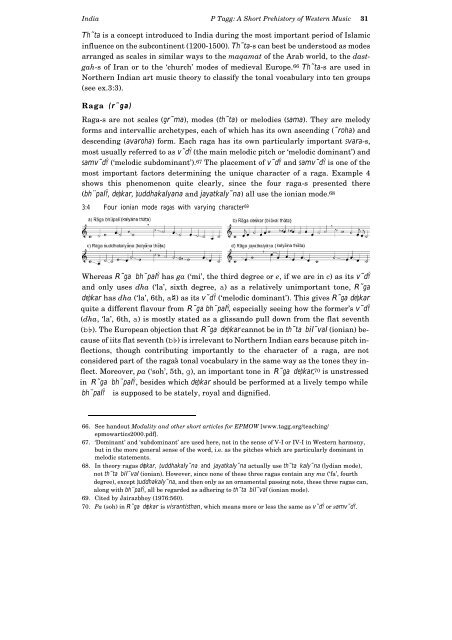A Short Prehistory of Western Music, Chapter 3
A Short Prehistory of Western Music, Chapter 3
A Short Prehistory of Western Music, Chapter 3
Create successful ePaper yourself
Turn your PDF publications into a flip-book with our unique Google optimized e-Paper software.
India P Tagg: A <strong>Short</strong> <strong>Prehistory</strong> <strong>of</strong> <strong>Western</strong> <strong>Music</strong> 31<br />
Th˜ta is a concept introduced to India during the most important period <strong>of</strong> Islamic<br />
influence on the subcontinent (1200-1500). Th˜ta-s can best be understood as modes<br />
arranged as scales in similar ways to the maqamat <strong>of</strong> the Arab world, to the dastgah-s<br />
<strong>of</strong> Iran or to the ‘church’ modes <strong>of</strong> medieval Europe. 66 Th˜ta-s are used in<br />
Northern Indian art music theory to classify the tonal vocabulary into ten groups<br />
(see ex.3:3).<br />
Raga (r˜ga)<br />
Raga-s are not scales (gr˜ma), modes (th˜ta) or melodies (sama). They are melody<br />
forms and intervallic archetypes, each <strong>of</strong> which has its own ascending (˜roha) and<br />
descending (avaroha) form. Each raga has its own particularly important svara-s,<br />
most usually referred to as v˜dŸ (the main melodic pitch or ‘melodic dominant’) and<br />
samv˜dŸ (‘melodic subdominant’). 67 The placement <strong>of</strong> v˜dŸ and samv˜dŸ is one <strong>of</strong> the<br />
most important factors determining the unique character <strong>of</strong> a raga. Example 4<br />
shows this phenomenon quite clearly, since the four raga-s presented there<br />
(bh¨palŸ, deþkar, þuddhakalyana and jayatkaly˜na) all use the ionian mode. 68<br />
3:4 Four ionian mode ragas with varying character 69<br />
Whereas R˜ga bh¨palŸ has ga (‘mi’, the third degree or e, if we are in c) as its v˜dŸ<br />
and only uses dha (‘la’, sixth degree, a) as a relatively unimportant tone, R˜ga<br />
deþkar has dha (‘la’, 6th, a8) as its v˜dŸ (‘melodic dominant’). This gives R˜ga deþkar<br />
quite a different flavour from R˜ga bh¨palŸ, especially seeing how the former’s v˜dŸ<br />
(dha, ‘la’, 6th, a) is mostly stated as a glissando pull down from the flat seventh<br />
(b$). The European objection that R˜ga deþkar cannot be in th˜ta bil˜val (ionian) because<br />
<strong>of</strong> iits flat seventh (b$) is irrelevant to Northern Indian ears because pitch inflections,<br />
though contributing importantly to the character <strong>of</strong> a raga, are not<br />
considered part <strong>of</strong> the raga’s tonal vocabulary in the same way as the tones they inflect.<br />
Moreover, pa (‘soh’, 5th, g), an important tone in R˜ga deþkar, 70 is unstressed<br />
in R˜ga bh¨palŸ , besides which deþkar should be performed at a lively tempo while<br />
bh¨palŸ is supposed to be stately, royal and dignified.<br />
66. See handout Modality and other short articles for EPMOW [www.tagg.org/teaching/<br />
epmowartics2000.pdf].<br />
67. ‘Dominant’ and ‘subdominant’ are used here, not in the sense <strong>of</strong> V-I or IV-I in <strong>Western</strong> harmony,<br />
but in the more general sense <strong>of</strong> the word, i.e. as the pitches which are particularly dominant in<br />
melodic statements.<br />
68. In theory ragas deþkar, þuddhakaly˜na and jayatkaly˜na actually use th˜ta kaly˜na (lydian mode),<br />
not th˜ta bil˜val (ionian). However, since none <strong>of</strong> these three ragas contain any ma (‘fa’, fourth<br />
degree), except þuddhakaly˜na, and then only as an ornamental passing note, these three ragas can,<br />
along with bh¨palŸ, all be regarded as adhering to th˜ta bil˜val (ionian mode).<br />
69. Cited by Jairazbhoy (1976:560).<br />
70. Pa (soh) in R˜ga deþkar is visrantisthan, which means more or less the same as v˜dŸ or samv˜dŸ.














